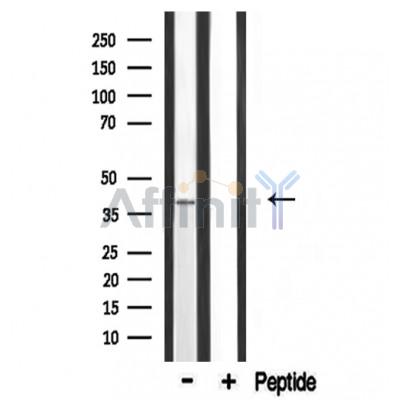5HT1F Receptor Antibody - #DF3499
| 製品: | 5HT1F Receptor Antibody |
| カタログ: | DF3499 |
| タンパク質の説明: | Rabbit polyclonal antibody to 5HT1F Receptor |
| アプリケーション: | WB IF/ICC |
| Cited expt.: | WB, IF/ICC |
| 反応性: | Human, Mouse, Rat |
| 予測: | Pig, Bovine, Horse, Sheep, Rabbit, Dog, Chicken, Xenopus |
| 分子量: | 38 KD; 42kD(Calculated). |
| ユニプロット: | P30939 |
| RRID: | AB_2835861 |
製品説明
*The optimal dilutions should be determined by the end user. For optimal experimental results, antibody reuse is not recommended.
*Tips:
WB: For western blot detection of denatured protein samples. IHC: For immunohistochemical detection of paraffin sections (IHC-p) or frozen sections (IHC-f) of tissue samples. IF/ICC: For immunofluorescence detection of cell samples. ELISA(peptide): For ELISA detection of antigenic peptide.
引用形式: Affinity Biosciences Cat# DF3499, RRID:AB_2835861.
折りたたみ/展開
5 HT 1F; 5 HT1F; 5 hydroxytryptamine (serotonin) receptor 1F; 5 hydroxytryptamine 1F receptor; 5 hydroxytryptamine receptor 1E beta; 5 hydroxytryptamine receptor 1F; 5 hydroxytryptamine serotonin receptor 1E beta; 5 hydroxytryptamine serotonin receptor 1F; 5HT 1F; 5HT1F; HGNC5292; HTR 1F; HTR1EB; HTR1EL; HTR1F; MR 77; MR77; Serotonin receptor 1E beta; Serotonin receptor gene;
免疫原
A synthesized peptide derived from human 5HT1F Receptor, corresponding to a region within the internal amino acids.
- P30939 5HT1F_HUMAN:
- Protein BLAST With
- NCBI/
- ExPASy/
- Uniprot
MDFLNSSDQNLTSEELLNRMPSKILVSLTLSGLALMTTTINSLVIAAIIVTRKLHHPANYLICSLAVTDFLVAVLVMPFSIVYIVRESWIMGQVVCDIWLSVDITCCTCSILHLSAIALDRYRAITDAVEYARKRTPKHAGIMITIVWIISVFISMPPLFWRHQGTSRDDECIIKHDHIVSTIYSTFGAFYIPLALILILYYKIYRAAKTLYHKRQASRIAKEEVNGQVLLESGEKSTKSVSTSYVLEKSLSDPSTDFDKIHSTVRSLRSEFKHEKSWRRQKISGTRERKAATTLGLILGAFVICWLPFFVKELVVNVCDKCKISEEMSNFLAWLGYLNSLINPLIYTIFNEDFKKAFQKLVRCRC
種類予測
Score>80(red) has high confidence and is suggested to be used for WB detection. *The prediction model is mainly based on the alignment of immunogen sequences, the results are for reference only, not as the basis of quality assurance.
High(score>80) Medium(80>score>50) Low(score<50) No confidence
研究背景
G-protein coupled receptor for 5-hydroxytryptamine (serotonin). Also functions as a receptor for various alkaloids and psychoactive substances. Ligand binding causes a conformation change that triggers signaling via guanine nucleotide-binding proteins (G proteins) and modulates the activity of down-stream effectors, such as adenylate cyclase. Signaling inhibits adenylate cyclase activity.
Cell membrane>Multi-pass membrane protein.
Belongs to the G-protein coupled receptor 1 family.
研究領域
· Environmental Information Processing > Signal transduction > cAMP signaling pathway. (View pathway)
· Environmental Information Processing > Signaling molecules and interaction > Neuroactive ligand-receptor interaction.
· Organismal Systems > Nervous system > Serotonergic synapse.
· Organismal Systems > Sensory system > Taste transduction.
参考文献
Application: WB Species: Mouse Sample:
Application: WB Species: Rat Sample:
Application: IF/ICC Species: Rat Sample:
Restrictive clause
Affinity Biosciences tests all products strictly. Citations are provided as a resource for additional applications that have not been validated by Affinity Biosciences. Please choose the appropriate format for each application and consult Materials and Methods sections for additional details about the use of any product in these publications.
For Research Use Only.
Not for use in diagnostic or therapeutic procedures. Not for resale. Not for distribution without written consent. Affinity Biosciences will not be held responsible for patent infringement or other violations that may occur with the use of our products. Affinity Biosciences, Affinity Biosciences Logo and all other trademarks are the property of Affinity Biosciences LTD.



